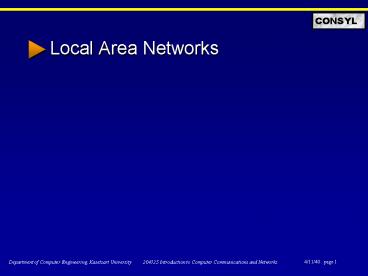Local Area Networks - PowerPoint PPT Presentation
1 / 18
Title:
Local Area Networks
Description:
FDDI -- Also using tokens, it is now a popular campus LAN. DQDB -- use in Metropolitan Area Network The physical layer specifies the electrical, mechanical, ... – PowerPoint PPT presentation
Number of Views:140
Avg rating:3.0/5.0
Title: Local Area Networks
1
Local Area Networks
2
LAN characteristics
- confined within geographical area
- relatively high data rate
- under single management
stations
stations
LAN Ingredients...
- Topology
- bus, star, ring
- Transmission medium
- twisted pair, coaxial, fiber optics, wireless
- Medium access techniques
- protocol to coordinate the sharing of media
station
router
server
3
Topology
- Topology defines how nodes/stations are connected
- LAN typical topology
- bus/tree all nodes connected to a common medium
- star all nodes are joined to a central nodes
- ring nodes form a ring by point-to-point links
to adjacent neighbors
ring
star
bus
4
Topology Bus
C
D
B
A
D
B and C
D
Application
Application
Presentation
Presentation
Session
Session
Transport
Transport
Network
Network
Data Link
Data Link
Physical
Physical
5
Topology Ring
A
A
- nodes function as a repeater
- only destination copies frame to it, all other
nodes have to discarded the frame - Unidirectional link
B
C
B
C
B transmits frame addressed to A
C ignores frame
A
A
B
C
B
C
A copies frame
C absorbs returning frame
6
Topology Star
- Each station attaches to the central node
- Two point-to-point links for tranmitting and
receiving - Two alternatives operation
- broadcasting
- switching
shared hub broadcast packet to every ports but
only destination copies frame
A
C
B
A
B
C
switch hub retransmitts packet to the
destination only
C transmitts frame addressed to A
A
B
C
7
Transmission media
- Twisted pair
- Cat 3 -- voice grade UTP, data rate up to 10Mbps
- Cat 5 -- data grade UTP, data rate 100 Mbps
- Coaxial cable
- baseband coaxial support data rates 20 Mbps at
distance of up to 2 km - Fiber optics
- support gigabit data rate and longer distances
8
Medium Access Control
- Protocol for controlling access to transmission
medium - Defined as part of Data Link layer
- The protocol performs
- perform functions related to medium access (MAC
sublayer) - concerned with the transmission of a link-level
between two nodes (LLC sublayer)
Network
LLC
Logical Link Control sublayer
Data Link
MAC
Medium Access Control sublayer
Physical
9
LLC Sublayer Functions
- Provides a compatibility interface, irrespective
of the MAC layer used. - Service Access Points (SAPs) interface sublayers
to upper-layer functions - Optional connection, flow control, and sequencing
services
10
MAC frame format
MAC Frame (802.3)
SAPs define a protocol for upper layer
LLC PDU
DSAP Destination Service Access Point SSAP
Source Service Access Point Control Command and
response functions Data LLC SDU
11
MAC Address
0000.0c12. 3456
ROM
RAM
- MAC address is burned into ROM on a network
interface card
12
MAC Strategies
- Where?
- centralized a designated station has an
authurity to grant access to the network - distributed stations can dynamically determined
transmission order - How?
- Sychronous dedicated specific capacity to a
conection - Asynchronous dynamic allocate capacity (3
categories available) - Round-robin
- Reservation
- Contention
13
MAC techniques
- Contention
- Medium is free for all
- A node senses the free medium and occupies it
- Example Ethernet, IEEE 802.3
- Round robin
- Give every body a turn
- Inefficient for lightly loaded network
- Example Token Ring/IEEE 802.5, Token Bus/IEEE
802.4, FDDI - Reservation
- schedule a time slot like TDM
- Example DQDB
14
Overview of LAN Standard
- 802.1 Overview
- 802.2 Logical Link Control
- 802.3 CSMA/CD (Ethernet)
- 802.4 Token Bus
- 802.5 Token Ring
- 802.6 Distributed Queue Dual BUS --MAN
standard - FDDI Fiber Distributed Data Interface
15
LAN/WAN layers comparison
- Separate physical and data link layer for LAN
and WAN
16
Ethenet/802.3 Operation
- Every node can receive a transmission by all
other nodes - need addressing scheme to identify a destination
- only destination copies frame to it, all other
nodes have to discarded the frame
C
B
C
A
B
A
terminator
C finds the bus is free
C transmits frame addressed to A
C
C
B
B
A
A
A copies frame
B ignores frame
signal is absorbed by the terminators
17
Token Ring/802.5 Operation
T
T 0
T 0
A
A
T
T 1
A
T
Data
- Token Ring LANs continuously pass a token or a
Token Ring frame
18
FDDI
FDDI Dual Ring
19
LAN Frame Format Summary
802.2 LLC
FDDI
FDDI uses 4-bits symbols
802.5
802.3
Ethernet































